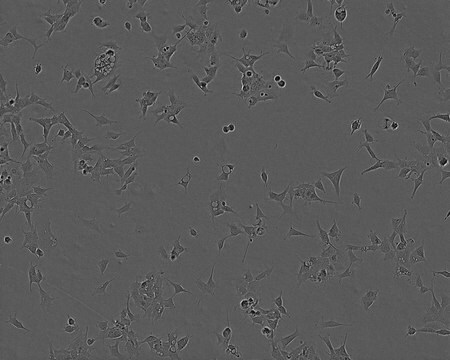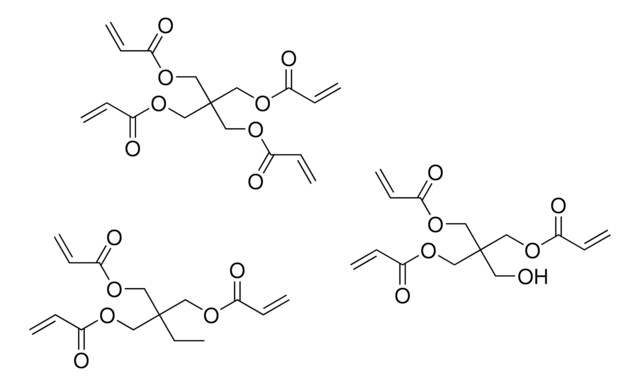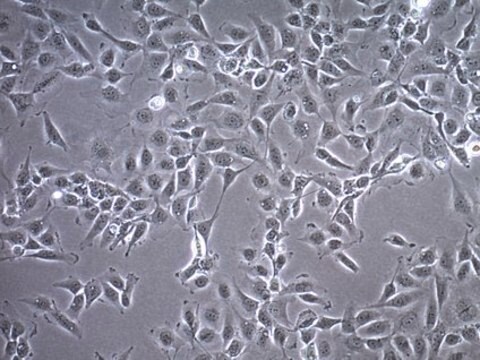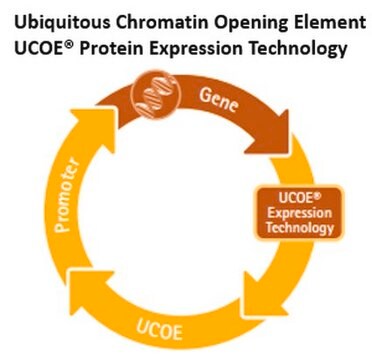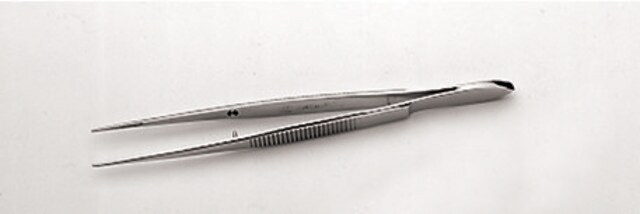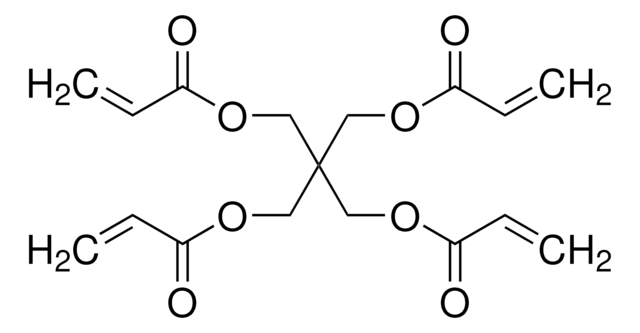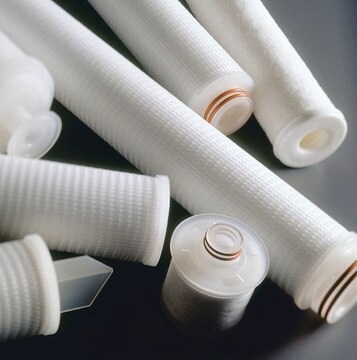SCC292
HEK293 FUS Knockout Human Cell Line
Human
Zaloguj sięWyświetlanie cen organizacyjnych i kontraktowych
About This Item
Kod UNSPSC:
41106514
NACRES:
NA.81
Polecane produkty
Nazwa produktu
HEK293 FUS Knockout Human Cell Line,
pochodzenie biologiczne
human
opakowanie
vial of >1X10⁶ cells
producent / nazwa handlowa
Millipore
tryb wzrostu
N/A
metody
cell culture | mammalian: suitable
Warunki transportu
dry ice
temp. przechowywania
−196°C
Opis ogólny
Stwardnienie zanikowe boczne (ALS, choroba Charcota lub Lou Gehriga) jest postępującą chorobą neurodegeneracyjną powodującą utratę kontroli motorycznej. ALS zwykle prowadzi do śmierci w ciągu 5 lat od wystąpienia objawów.1 Pewna część przypadków ALS występuje rodzinnie i jest związana z chorobą Lou Gehriga.
Zastosowanie
- Każda fiolka zawiera >1X106żywych komórek.
- Komórki są testowane pod kątem chorób zakaźnych za pomocą panelu Human Essential CLEAR firmy Charles River Animal Diagnostic Services.
- Komórki zostały zweryfikowane jako pochodzące od człowieka i są ujemne pod względem zanieczyszczenia międzygatunkowego pochodzącego od myszy, szczurów, chomika chińskiego, chomika syryjskiego złocistego i naczelnych (NHP), zgodnie z panelem Contamination Clear firmy Charles River Animal Diagnostic Services.
- Komórki nie są skażone mykoplazmą.
Stwardnienie zanikowe boczne (ALS, znane również jako choroba Charcota lub Lou Gehriga) jest postępującą chorobą neurodegeneracyjną powodującą utratę kontroli motorycznej. ALS zwykle prowadzi do śmierci w ciągu 5 lat od wystąpienia objawów.1 Część przypadków ALS jest rodzinna i powiązana z mutacjami w kilku genach, w tym FUS (fuzja w mięsaku). FUS jest białkiem wiążącym rybonukleotydy, które odgrywa rolę w metabolizmie RNA i jest zaangażowane w szlaki naprawy DNA.2 Badanie skutków mutacji punktowych FUS przyczynia się do naszego zrozumienia mechanizmów komórkowych ALS i powiązań między naprawą genetyczną a neurodegeneracją.
Źródło
Linia komórkowa HEK293 FUS KO została wyprowadzona z komórek HEK293 poddanych edycji CRISPR.2 Rodzicielska linia komórkowa HEK293 została wyprowadzona z komórek abortowanego płodu żeńskiego transfekowanego ściętym DNA adenowirusa.3
Referencje
1. Zarei S, Carr K, Reiley L, Diaz K, Guerra O et al. Surg Neurol Int 2015; 6:171.
2. Wang H, Guo W, Mitra J, Hegde PM, Vandoorne T et al. Nat Commun 2018; 9:3683.
3. Graham FL, Smiley J, Russell, WC, Nairn R. J Gen Virol 1977; 36(1): 59-74.
Źródło
Linia komórkowa HEK293 FUS KO została wyprowadzona z komórek HEK293 poddanych edycji CRISPR.2 Rodzicielska linia komórkowa HEK293 została wyprowadzona z komórek abortowanego płodu żeńskiego transfekowanego ściętym DNA adenowirusa.3
Referencje
1. Zarei S, Carr K, Reiley L, Diaz K, Guerra O et al. Surg Neurol Int 2015; 6:171.
2. Wang H, Guo W, Mitra J, Hegde PM, Vandoorne T et al. Nat Commun 2018; 9:3683.
3. Graham FL, Smiley J, Russell, WC, Nairn R. J Gen Virol 1977; 36(1): 59-74.
Cechy i korzyści
Linia komórkowa HEK293 FUS knockout została uzyskana poprzez edycję CRISPR/Cas9 komórek HEK293. Eksperymentalna walidacja tej linii potwierdziła delecję FUS bez wpływu na ekspresję powiązanych białek.2 Ta linia komórkowa FUS knockout pozwala na bezpośrednie badanie skutków mutacji FUS poprzez transfekcję wariantów FUS. Linia komórkowa HEK293 FUS knockout stanowi cenny system do badania rodzinnego ALS w solidnym modelu komórkowym.
Przechowywanie i stabilność
Komórki powinny być przechowywane w ciekłym azocie do momentu użycia. Komórki mogą być hodowane przez co najmniej 10 pasaży po wstępnym rozmrożeniu bez znaczącego wpływu na ekspresję markerów komórkowych i ich funkcjonalność.
Inne uwagi
Ten produkt jest przeznaczony do sprzedaży i sprzedawany wyłącznie instytucjom akademickim do wewnętrznego użytku akademickiego zgodnie z warunkami "Umowy o użytkowaniu akademickim", jak wyszczególniono w dokumentacji produktu.
Oświadczenie o zrzeczeniu się odpowiedzialności
O ile nie określono inaczej w naszym katalogu lub innej dokumentacji firmy dołączonej do produktu(-ów), nasze produkty są przeznaczone wyłącznie do użytku badawczego i nie mogą być wykorzystywane do żadnych innych celów, w tym między innymi do nieautoryzowanych zastosowań komercyjnych, zastosowań diagnostycznych in vitro, zastosowań terapeutycznych ex vivo lub in vivo lub jakiegokolwiek rodzaju konsumpcji lub zastosowania u ludzi lub zwierząt.
WYŁĄCZNIE DO CELÓW BADAWCZYCH. Ten produkt podlega regulacjom prawnym we Francji, jeśli jest przeznaczony do celów naukowych, w tym do importu i eksportu (art. L 1211-1 ust. 2 kodeksu zdrowia publicznego). Nabywca (tj. użytkownik końcowy) jest zobowiązany do uzyskania zezwolenia na import od francuskiego Ministerstwa Badań Naukowych, o którym mowa w artykule L1245-5-1 II Kodeksu Zdrowia Publicznego. Zamawiając ten produkt, użytkownik potwierdza, że uzyskał odpowiednie zezwolenie na import.
Ta strona może zawierać tekst przetłumaczony maszynowo.
Kod klasy składowania
10 - Combustible liquids
Klasa zagrożenia wodnego (WGK)
WGK 1
Temperatura zapłonu (°F)
Not applicable
Temperatura zapłonu (°C)
Not applicable
Certyfikaty analizy (CoA)
Poszukaj Certyfikaty analizy (CoA), wpisując numer partii/serii produktów. Numery serii i partii można znaleźć na etykiecie produktu po słowach „seria” lub „partia”.
Masz już ten produkt?
Dokumenty związane z niedawno zakupionymi produktami zostały zamieszczone w Bibliotece dokumentów.
Nasz zespół naukowców ma doświadczenie we wszystkich obszarach badań, w tym w naukach przyrodniczych, materiałoznawstwie, syntezie chemicznej, chromatografii, analityce i wielu innych dziedzinach.
Skontaktuj się z zespołem ds. pomocy technicznej